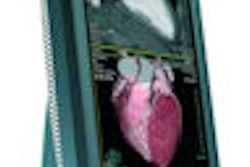Practical ergonomic initiatives can help decrease repetitive stress injuries for radiologic technologists working in a PACS environment, according to research presented at the recent American Roentgen Ray Society (ARRS) meeting in Boston.
"Radiology departments should implement ergonomic initiatives to reduce the risk of repetitive stress injuries and injuries among their technologists," said Dr. Phillip Boiselle of Beth Israel Deaconess Medical Center in Boston. He presented the team's research during a scientific session at the show.
Repetitive stress injuries and symptoms are commonplace, and one in three work-related injuries is thought to be due to repetitive use, Boiselle said. Radiologists and technologists are at high risk, but the prevalence of symptoms and injuries is unknown, he said.
Although ergonomics can reduce the risk of injury, the effects of ergonomic initiatives on technologists are also currently unknown, Boiselle said. To determine the prevalence of repetitive stress symptoms among technologists working in a PACS environment, as well as assess their response to ergonomic interventions, the study team surveyed 209 technologists working in a PACS-based radiology department.
The survey, designed in conjunction with an occupational health specialist, was initially distributed in a hard-copy format at a grand rounds meeting in December 2006. Follow-up e-mails provided an electronic survey link to enhance the level of response, according to Boiselle.
The survey asked questions related to the presence of repetitive stress syndrome, prior diagnosis of repetitive stress syndrome, the number of hours spent per day working at a personal computer or PACS monitor, and whether they spent more than two hours per day in an awkward posture.
In addition, respondents who had received new ergonomic chairs, ergonomic workstations, or ergonomic training were asked to rank how these interventions affected the severity of repetitive stress injuries using a seven-point Likert scale (-3 [markedly worse] to +3 [markedly better]). Respondents were also given space to provide narrative comments.
Of the 209 technologists, 128 responded (61% response rate), with 74% reporting repetitive stress symptoms, and 41% stating they had a prior diagnosis of repetitive stress syndrome.
Fifty-nine percent reported they worked more than eight hours per day at a PC or PACS monitor. In addition, 70% said they spent more than two hours per day in an awkward position.
Improvement in repetitive stress symptoms (defined as a Likert scale score of +1 to +3) was seen in 55% of the 58 respondents who had received ergonomic chairs. As for the 33 respondents who received ergonomic workstations, 42% reported an improvement in repetitive stress symptoms.
Of the 17 who underwent ergonomic training, 35% said it led to an improvement in their symptoms. Ten respondents reported the need for additional ergonomic chairs and workstations.
Boiselle acknowledged several limitations of the study, including its reliance on data from a single institution and a lack of comparison of subspecialty areas, due to the study design. Future research will examine subspecialty differences, as well as technologist-specific activities such as handling equipment and performing patient transfers, he said.
"Repetitive stress symptoms are highly prevalent among radiology techs working in a PACS-based environment and are modestly responsive to ergonomic interventions," he concluded.
By Erik L. Ridley
AuntMinnie.com staff writer
May 18, 2009
Related Reading
Wii remote, Baroque music can lighten the load in reading rooms, April 28, 2009
Lean management plays key role in new hospital design, March 8, 2009
PACS software tool boosts clinical follow-up, December 15, 2008
PACS comes with risk of repetitive stress injuries, September 8, 2008
Lean principles and ergonomics aid imaging management, April 30, 2008
Copyright © 2009 AuntMinnie.com



















